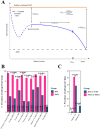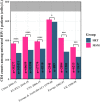Transmitted HIV-1 is more virulent in heterosexual individuals than men-who-have-sex-with-men
- PMID: 35271687
- PMCID: PMC8912199
- DOI: 10.1371/journal.ppat.1010319
Transmitted HIV-1 is more virulent in heterosexual individuals than men-who-have-sex-with-men
Abstract
Transmission bottlenecks introduce selection pressures on HIV-1 that vary with the mode of transmission. Recent studies on small cohorts have suggested that stronger selection pressures lead to fitter transmitted/founder (T/F) strains. Manifestations of this selection bias at the population level have remained elusive. Here, we analysed early CD4 cell count measurements reported from ∼340,000 infected heterosexual individuals (HET) and men-who-have-sex-with-men (MSM), across geographies, ethnicities and calendar years. The reduction in CD4 counts early in infection is reflective of the virulence of T/F strains. MSM and HET use predominant modes of transmission, namely, anal and penile-vaginal, with among the largest differences in the selection pressures at transmission across modes. Further, in most geographies, the groups show little inter-mixing, allowing for the differential selection bias to be sustained and amplified. We found that the early reduction in CD4 counts was consistently greater in HET than MSM (P<0.05). To account for inherent variations in baseline CD4 counts, we constructed a metric to quantify the extent of progression to AIDS as the ratio of the reduction in measured CD4 counts from baseline and the reduction associated with AIDS. We found that this progression corresponding to the early CD4 measurements was ∼68% for MSM and ∼87% for HET on average (P<10-4; Cohen's d, ds = 0.36), reflecting the more severe disease caused by T/F strains in HET than MSM at the population level. Interestingly, the set-point viral load was not different between the groups (ds<0.12), suggesting that MSM were more tolerant and not more resistant to their T/F strains than HET. This difference remained when we controlled for confounding factors using multivariable regression. We concluded that the different selection pressures at transmission have resulted in more virulent T/F strains in HET than MSM. These findings have implications for our understanding of HIV-1 pathogenesis, evolution, and epidemiology.
Conflict of interest statement
The authors have declared that no competing interests exist.
Figures




References
-
- Carlson J. M. et al.. Selection bias at the heterosexual HIV-1 transmission bottleneck. Science 345, 1254031 (2014). URL https://science.sciencemag.org/content/345/6193/1254031 - PMC - PubMed
-
- Claiborne D. T. et al.. Replicative fitness of transmitted HIV-1 drives acute immune activation, proviral load in memory CD4+ T cells, and disease progression. Proc. Natl. Acad. Sci. U.S.A. 112, E1480–1489 (2015). URL https://www.pnas.org/content/112/12/E1480 - PMC - PubMed
Publication types
MeSH terms
Grants and funding
LinkOut - more resources
Full Text Sources
Medical
Research Materials
Miscellaneous

